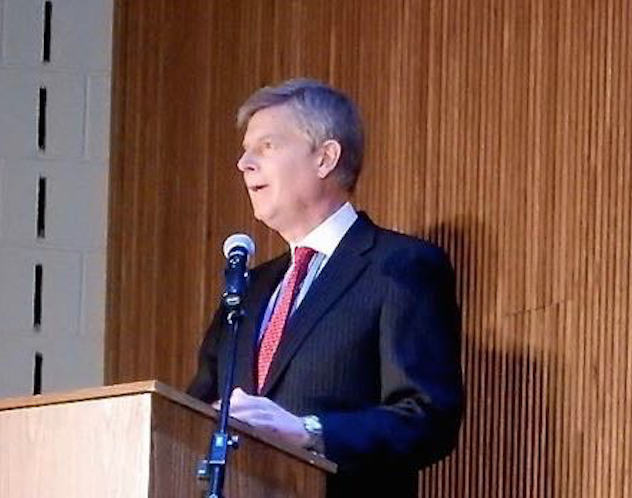Why we bought Central Middle and believe in PARC

Oct. 31, 2018 PLYMOUTH VOICE.
Plymouth Michigan News
GUEST EDITORIAL
By: Mark Malcolm
There are two key reasons why Patty and I got involved. First, we believe that demolition of this historic building and replacing it with a massive new sub-division would devastatingly alter and forever diminish the character and feel of our community. Second, the vision for this site to be adaptively re-purposed into a high-quality Arts & Recreation Complex struck us as a great potential value-add proposition for Plymouth. Unfortunately, the Township Administration back then (2014) had its own agenda, which was intended to block PARC and leave developers as the only viable buyers. That’s when we decided to step in to secure the property in order to give PARC a chance — in the hope that residents would one day be allowed to decide if the benefits vs. cost warrant community funding assistance. That will happen on November 6.
The progress at PARC has been nothing short of phenomenal. With about 30 tenants (including the College for Creative Studies; Friends of the Rouge; the Michigan Philharmonic and Youth Orchestra; the region’s top fine artist, Tony Roko; youth plays and musicals; the Cruisers swim team; Steelers football; teenage music creation and appreciation; pottery; glass blowing; culinary arts; opera; music and voice instruction for youth and adults; dance; photography; autism therapy; open swimming, basketball and pickleball; fitness studio; and more), PARC is already providing a diverse range of high-quality participation opportunities for Plymouth residents of all ages that surpasses anything offered in surrounding communities.
But what benefit is PARC if you do not participate in any of the activities? Expected higher property value. So says Anderson Economic Group, an international expert firm that did an in-depth study of PARC and Plymouth and concluded, based on results of similar situations in other communities, that the increased quality-of-life opportunities will increase the value of Plymouth homes. Just as good schools, good library, good Township Park, and a good downtown contribute to making Plymouth a desirable place to live, so will PARC.
Will your anticipated economic benefit exceed the cost of the millage? We strongly believe yes. The increased property tax for an average Plymouth home would be about $95 a year (or $8 a month), totaling about $1,900 spread over 20 years. For all Plymouth residents, this millage would represent only about a 2% increase in your present property tax bill. On the positive side, the average assessed value of a home in Plymouth is about $310,000, so a mere one percent increase in value would be worth about $3,100, resulting in a net “profit” (benefit exceeding cost) of about $1,200 per average homeowner.
Our confidence in PARC’s value to the community reflects not only the economic and intangible benefits, but also the excellent work done on cost management. To replicate the planned facilities by building all new would cost an estimated 2 to 3 times as much as the millage proposal! The savings in up-front capital reflects re-using and modernizing the existing facilities (building, gym, pool), having tenants fund desired improvements in their rooms, having the Performing Arts Center as part of the Complex (which allows cost reduction by not replicating some of what’s available in the nearby existing building), and $6 million of private donations.
In addition to getting great value in the up-front investment, it was mandatory to the PARC Board to develop a viable Business Plan that avoids the sizable ongoing annual cash losses that routinely plague traditional “community centers”. To get different results, the approach needs to be different — and it is. PARC is not a government-staffed and government-run operation with high overhead costs to provide programs. PARC is headed up by business people who employ lean staffing, volunteer assistance, good cost control, and programs provided by the tenant organizations; rather than incurring cost to put on programs, PARC collects rent. In the words of Stout, Risius, Ross (a leading independent business advisory firm), PARC “has created a competitive advantage over similar properties.” This independent expert concluded that PARC should be financially self-sufficient on a going basis IF it receives the capital support requested in the millage and if the day-to-day operations are managed by a business-oriented, private (i.e., non-governmental) non-profit organization like PARC.
Which leads to the natural and oft-asked questions: Why not leave PARC as it is and not add a Performing Arts Center (PAC)?, and What’s “Plan B” if the millage fails? Simply put, we believe the PAC is required to make the total Complex confidently self-sustaining. With the great progress to date in the existing facility and projected further improvements, we are doing MUCH better than other community centers, but still have a realistically forecasted cash loss of about $50,000 per year; as with your own home, PARC actually needs to generate a modest annual surplus in order to pay for potential emergency repairs and long-term maintenance. An extensive survey of likely users of the planned PAC indicates more than enough annual demand, in combination with our rental model and operating cost-sharing savings with the existing facility, to generate the additional cash flow needed to make the total Complex financially viable. That’s what Stout concluded, and so did the Plymouth Chamber of Commerce. The cost for the PAC is about half of the total millage cost, or $4 a month for the average homeowner, representing a 1% increase in your present property taxes.
Regarding Plan B, the honest answer is, “We don’t know.” Late last year, Patty and I charitably contributed our property rights to Community Foundation (CF), arguably the pre-eminent philanthropic organization in southeast Michigan. CF has all the legal authority. It intends to donate the property to the Plymouth Area Recreational Authority IF the millage passes; if it fails, CF will assess the outlook and alternatives and make the call on what happens. Make no mistake — Patty and I will do everything in our power to keep the existing building and tenant organizations in our hometown. In the end, however, the decision belongs to CF and we believe they will need to see a viable financial plan in order to donate the property to PARC or anyone. As previously stated, such a plan does not presently exist. As a result, it is very possible that CF, in carrying out its fiduciary responsibility, could sell to the highest bidder. If that happens, all proceeds would be owned by CF and have to be distributed over time to charitable organizations. By law, no proceeds from Central can ever come to Patty and me.
I realize that much of what I have said is wildly different (and more positive for the community) than what has been spread by a handful of aggressively vocal residents. For fair-minded people trying to determine what’s true and what’s false, I ask you to consider the credibility of the source. Here is some of my background:
– Decades of financial leadership positions at Ford (then ranked #1 in corporate finance), focused on cost management, capital spending, and forecasting in Manufacturing and Purchasing.
– Nine years as CEO of auto supplier Tower, with over $2 billion of annual revenue and 9,000 employees.
– Took over Tower as it was exiting bankruptcy, survived the massive downturn in 2008-09 without government assistance, and became the first auto IPO in 5 years.
– Tower reported financial results 26 times when I was CEO; all 26 times, our results met or beat the forecast by the Wall Street analysts.
– In 2013, Tower was the #1 performer of all Michigan companies on the New York Stock Exchange.
– In 2014, Tower was ranked #1 on the list published in Forbes magazine of “Most Trustworthy Companies” in North America.
– Was elected to the Board of major aerospace and defense company, General Dynamics, in 2015; presently serve as Chair of the Audit Committee, which is responsible for the correctness of the financial statements and disclosures provided to investors and the SEC.
– Similar to what we hope will be accomplished with PARC (but on a smaller financial scale), Patty and I purchased the iconic downtown Post Office with a vision to historically preserve it and keep it alive by re-purposing it into a specialty grocery market. Many said that would never work; this year, Westborn Market won statewide awards for Best Building Preservation and Best Downtown Development Over $1 Million.
– About 10 years ago, we saved c.1834 “Pumpkin Hill” (located across the street from PARC), preserving what we could and modernizing one of the oldest remaining homes in Plymouth.
I won’t speculate on the knowledge, credentials, or real motivation of the people making different financial claims (and, on the eve of the vote, making outlandish claims on other matters). Who’s more credible, and who should you believe? You decide.
We feel blessed to have had the financial good fortune to be able to purchase Central Middle and are humbled by the opportunities to give back to the community. We are passionately convinced that PARC can become an incredible value-added asset for us all, with scope and quality superior to anything in this region, not only benefitting present families, but also providing a lasting legacy contribution for generations to come. It truly is a “once in a lifetime opportunity”. That said, we understand and respect that reasonable people can reach different opinions from the same facts. All we’ve ever worked for and asked for was a chance to present the facts and let the residents decide. What happens after November 6 will reflect the will of the people.
Plymouth Voice.


